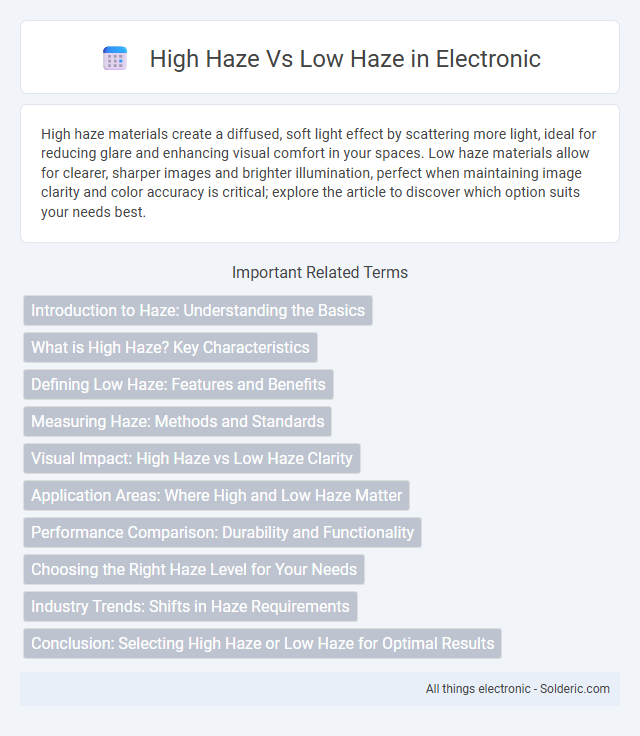High haze materials create a diffused, soft light effect by scattering more light, ideal for reducing glare and enhancing visual comfort in your spaces. Low haze materials allow for clearer, sharper images and brighter illumination, perfect when maintaining image clarity and color accuracy is critical; explore the article to discover which option suits your needs best.
Comparison Table
| Feature | High Haze | Low Haze |
|---|---|---|
| Definition | Indicates high light scattering reducing visibility | Indicates low light scattering, clearer visibility |
| Visibility Impact | Significant reduction in visibility | Minimal impact on visibility |
| Common Causes | Smoke, pollution, moisture, dust | Clear air, low particulate matter |
| Optical Clarity | Poor optical clarity | High optical clarity |
| Measurement | Haze value typically above 10% | Haze value typically below 5% |
| Impact on Photography | Blurry, washed-out images | Sharp, vibrant images |
| Effect on Air Quality | Decreased air quality, possible health risks | Better air quality, healthier environment |
Introduction to Haze: Understanding the Basics
Haze refers to the diffused light effect caused by microscopic particles suspended in the air or on surfaces, impacting clarity and sharpness in images or displays. High haze indicates a greater scattering of light, resulting in a softer, more diffused appearance, while low haze offers crisper, clearer visuals with minimal diffusion. Understanding the difference between high haze and low haze is essential for optimizing your product's visual performance and achieving the desired balance between clarity and softness.
What is High Haze? Key Characteristics
High Haze refers to a type of cannabis concentrate that retains a significant amount of plant material and terpenes, resulting in a cloudy and aromatic extract. Key characteristics include a higher terpene content, a more complex flavor profile, and a less purified appearance compared to low haze extracts. This concentrate often offers a more robust and flavorful experience due to the preservation of the cannabis strain's original terpene spectrum.
Defining Low Haze: Features and Benefits
Low haze refers to the minimal scattering of light that maintains clarity and sharpness in displays or glass surfaces. This feature enhances visual performance by delivering vivid colors and high contrast, making images appear more crisp and detailed. Benefits include improved readability, reduced eye strain, and superior aesthetic appeal in environments requiring precise visuals such as monitors, smartphones, and architectural glass.
Measuring Haze: Methods and Standards
Haze measurement relies on standardized methods such as ASTM D1003, which quantifies total light scattering to determine haze levels in materials. High haze samples exhibit greater light diffusion, measured by a haze meter that calculates the percentage of transmitted light scattered beyond a specified angle. Low haze materials maintain clarity with minimal light scattering, ensuring precise control in quality assurance processes for coatings, plastics, and optical products.
Visual Impact: High Haze vs Low Haze Clarity
High haze coatings scatter more light, resulting in a diffused appearance that softens reflections and reduces glare but sacrifices sharpness. Low haze coatings maintain clarity by minimizing light diffusion, delivering sharper, more defined reflections and greater visual precision. Selecting the appropriate haze level depends on the desired balance between glare reduction and image clarity in applications like automotive finishes or architectural glass.
Application Areas: Where High and Low Haze Matter
High haze materials are crucial in applications requiring pronounced light diffusion, such as LED lighting and display screens, to reduce glare and enhance visual comfort. Low haze films are preferred in packaging and protective covers where clarity and transparency are paramount for product visibility and aesthetics. Understanding the specific haze requirements in industries like automotive glass and solar panels ensures optimal performance tailored to environmental and functional needs.
Performance Comparison: Durability and Functionality
High Haze materials exhibit superior durability, maintaining optical clarity and resistance to scratches under prolonged exposure to environmental stressors, compared to Low Haze variants. Low Haze products, while offering slightly clearer transparency, tend to show increased susceptibility to surface damage and decreased material longevity when subjected to harsh conditions. The enhanced structural integrity of High Haze formulations ensures consistent functionality in demanding applications such as automotive lenses and protective coatings.
Choosing the Right Haze Level for Your Needs
Choosing the right haze level depends on your production environment and lighting setup. High haze creates a thick, textured atmosphere ideal for dramatic lighting effects and enhancing volumetric beams, while low haze offers subtle diffusion that preserves clarity and reduces buildup on lighting fixtures. Understanding your specific needs will help you optimize visibility and ambiance effectively.
Industry Trends: Shifts in Haze Requirements
Industry trends reveal a growing preference for low haze formulations in automotive coatings, driven by increasing consumer demand for clearer, glossier finishes. High haze coatings remain relevant in niche applications requiring textured or matte surfaces, but the market shift toward aesthetics and optical clarity fuels innovation in low haze technology. Manufacturers invest in developing advanced polymers and additives to optimize low haze performance while balancing durability and environmental compliance.
Conclusion: Selecting High Haze or Low Haze for Optimal Results
Selecting between high haze and low haze depends on the desired optical effect and application. High haze materials diffuse light more effectively, ideal for glare reduction and uniform illumination, while low haze materials preserve clarity and sharpness, suitable for displays and optical lenses. Optimal results require balancing diffusion and transparency based on specific requirements such as brightness, contrast, and ambient lighting conditions.
High Haze vs Low Haze Infographic

 solderic.com
solderic.com